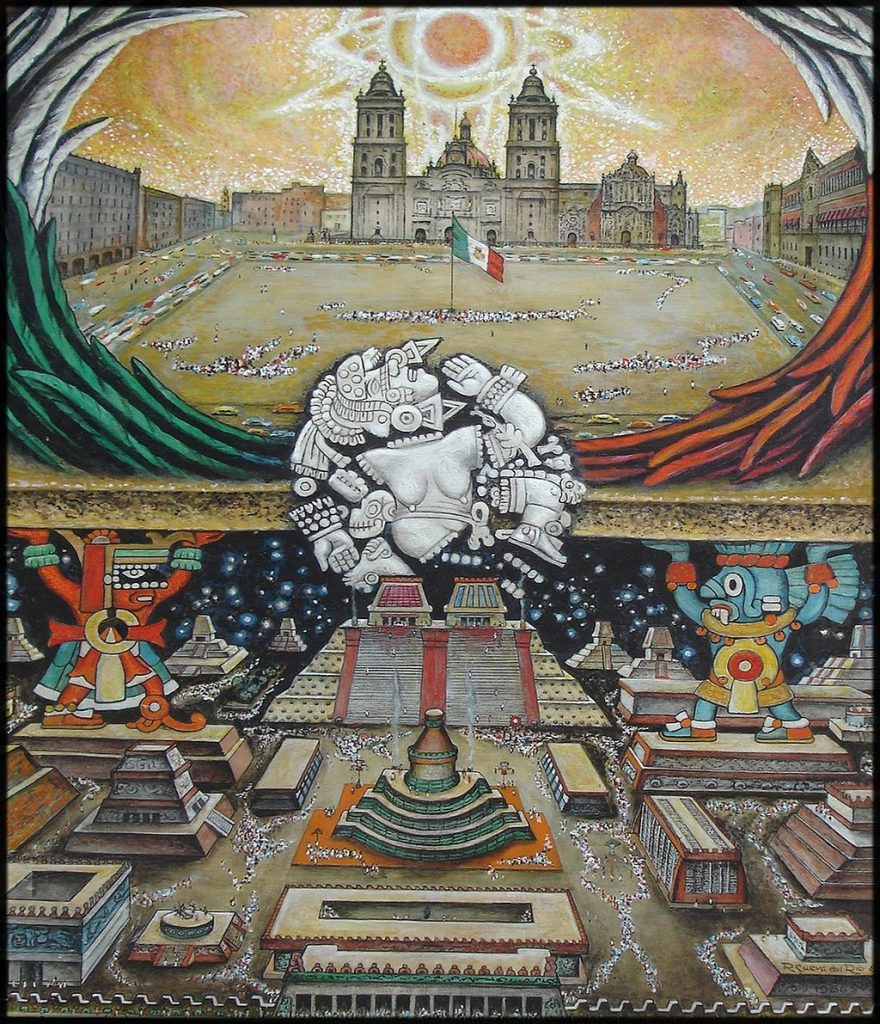When the Spanish conquistadors arrived in the valley of Mexico, they discovered something mystical. They viewed this place as the Venice of the New World. There were glamorous pyramids, exceptionally clean streets, grand aqueducts, lavish ball courts… all floating on a lake. This magical city, known as Tenochtitlan, was built by the Aztecs, the same group of people many look down upon because of their brutality, ferocity, and their practice of human sacrifice. Though many view the Aztecs as cold-hearted murderers, this is not the full story. Yes, they did practice human sacrifice, but much like other civilizations, they also had art, building projects, literature, religion, and a rich culture. But how is it that these people became a superpower of the Americas?
According to legend, the Aztecs, also known as the Mexica, hailed from a beautiful place known as Aztlan, which means “Land of the cranes.” Much like the mythical Greek city Atlantis, no one really knows where Aztlan is or even if it existed. In fact, the Aztec story about Aztlan is only one of several origin stories they tell. One legend has it, however, that one day their god, Huitzilopochtli, told the Mexica people to leave their land and find a new home, and they did. After more than two centuries of migrating, the Mexica grew more and more desperate to find that new home. Then they discovered the valley of Mexico. But they weren’t the only ones to settle there. Tribes such as the Azcapotzalco, the Culhuacán, and the peoples of Texcoco had gotten there long before they had. The only land that was still available to the Mexica was the nasty marshlands around Lake Texcoco, which the others had not wanted. And yet it was here that the Mexica had a vision. It was here that their sun god Huitzilopochtli gave them a sign: an eagle perched on a cactus eating a snake. That is why Mexico’s flag today has an eagle eating a snake. It meant that the Mexica (the Aztecs) had finally found their new home.1
Settling down in the Valley of Mexico was anything but easy. For one thing, objects would sink easily in the poor marshy grounds, which were in the middle of Lake Texcoco; yet this is where the Aztec’s creative engineering would come into play. Under their leader Tenoch, from which the name Tenochtitlan comes, the Aztecs began building their new home, by trading waterfowl and fish for wood and stone from the other tribes.2 With the wood, they made stakes, which were driven into the marshy ground. They then filled the gaps in between the stakes with mud and stones, which would become a foundation for their city. In order to connect the island city to the mainland regions, they also made gigantic causeways, using the same principles for making their foundation and were several miles long. Another problem was the water in Lake Texcoco, which was salty. The Aztecs had to build an aqueduct that would transport fresh water from the distant Chapultepec hills to the city itself. This aqueduct used a pair of stone pipelines that used gravity to transport the water to the city, and parts of it still stand to this day.3 Though they fixed their foundation and their water problems, there was still one problem that the Aztecs had to face before they could become the dominant force of Mesoamerica.
As their population kept growing, the demand for food kept rising at an alarming rate, and this is where the Aztecs are distinct from other civilizations. First, they dug canals into the island’s marshes and chopped down the plants that were growing there. They then piled reeds on top of each other to make rafts and covered them with mud. Finally, they planted willows underneath the rafts to anchor them. And voilà, the Aztecs had their very own artificial floating gardens, known as chinampas. With water always available, these chinampas could produce crops year round, thus the Aztecs had an abundance of beans, corn, tomatoes, squash, and flowers.4

After several generations, Tenochtitlan became a city of wonder and reached a population of around 200,000 inhabitants, making it one of the largest cities in the world.5 The city was decorated with structures, such as the serpent wall that enclosed the sacred quarters of the city and contained the carvings of snakes. It also contained lavish temples, such as the temple of Xipe Totec and the temple of Quetzalcoatl, the god of the sky and wind. But at the heart of Tenochtitlan was an impressive sight to see. This magnificent edifice, known as the Templo Mayor, was a temple like no other. This 150 feet pyramid had a twin staircase that led up to the glamorous temples of Tlaloc, the rain god, and Huitzilopochtli, the same god who provided the Aztecs with the vision of their new home.6

In the Aztec tongue, Nahuatl, their word for city is actually two words in English: water mountain (atl tepetl).7 In many ways, Tenochtitlan was a mighty mountain that watched over the valley of Mexico with its striking glare. Long before Mexico City became a glimpse in the eyes of history and replaced this magnificent place, Tenochtitlan was a flourishing capital that was not necessarily built by a brutal and violent race. But rather by a people who didn’t let the impossible stop them from making their home a legendary reality.
- Jennifer Stock, “Tenochtitlán Is Founded,” Global Events: Milestone Events Throughout History, (Farmington Hills, MI: Gale, 2014), 23-24. ↵
- Jennifer Stock, “Tenochtitlán Is Founded,” Global Events: Milestone Events Throughout History, (Farmington Hills, MI: Gale, 2014), 23-24. ↵
- Sonia Benson, “The Rise of the Aztecs,” Early Civilizations in the Americas, Vol. 2 (Detroit: UXL, 2005), 465. ↵
- Sonia Benson, “The Rise of the Aztecs,” Early Civilizations in the Americas, Vol. 2 (Detroit: UXL, 2005), 461-462. ↵
- Sonia Benson, “The Rise of the Aztecs,” Early Civilizations in the Americas, Vol. 2 (Detroit: UXL, 2005), 461. ↵
- Charles Phillips, Aztec and Maya: The Complete Illustrated History: The Greatest Civilizations of Ancient Central America with 1000 Photographs, Paintings and Maps (New York: Metro Books, 2008), 430-431. ↵
- Charles Phillips, Aztec and Maya: The Complete Illustrated History: The Greatest Civilizations of Ancient Central America with 1000 Photographs, Paintings and Maps (New York: Metro Books, 2008), 56-57. ↵



43 comments
Eugenio Gonzalez
I enjoyed reading your article because I learned much about the Aztec divinities and stories. The article does an excellent job of highlighting the scientific innovations of the Aztecs under a situation in which they did not count on the advancements that other civilizations had. It is interesting to see the reaction of the Spaniards when they saw the city of Tenochtitlan, which they compared to Venice.
Olivia Tijerina
I appreciate the perceptive placed in the message of the Aztecs because what became known of then was the culture, that they had set like many of the multitude of other cultures have had during that time. Moreover, looking upon the foundation of the Aztecs can be apart of their impressive work done. Their city is most notable to mention of the works that have had caught the attention of the Spaniards ,once they have conquered them, rather then the other aspect that had.
Roberto Rodriguez
I do not think I have ever heard of the floating gardens, that was very inventive and something that I wish I would have seen. The more that I learn about the ancient civilizations in the early americas the more that I really come to appreciate them. Though they were not as advanced as the Romans or the Greeks, it is still interesting how inventive the Aztecs were to solve their own problems. We forget that they were really successful and they did more than just do human sacrifices.
Paul Garza
I love how the author ended the article with a positive statement about the aztec culture… steering away from the human sacrifices and focusing on their huge successes that would eventually turn into Mexico City! so amazing to think that a grand city was in the americas and was clean! I love hearing about tenochtitlan a once flourishing city that started the Mexican culture.
Juan Arceo
I have heard about the history of the founding of the Aztec capital of Tenochtitlan many times, and this article was no different. It always amazed me when I was a little kid and looking at the Mexican flag and thinking how did they get that design and once I learned about the history of the eagle eating a snake on top of a cactus, I was immediately amazed. This is why I absolutely love Mexico and all of its infamous history.
Amelia Hew
It is amazing to know how advance and creative the Aztecs were despite being know for their brutal ways and practice of human sacrifice. They managed to turn the poor marshy ground of the Valley of Mexico into a glorious city that would be remembered for many generations and the most admirable thing is that the Aztecs succeeded in supplying enough food and water for the growing population. From that, they rose to the top and became the dominant force of Mesoamerica which was not an easy task to complete. I love how the article tells the story of the Aztecs in a detailed but simple matter.
Andrew Petri
This article is very interesting and is about a topic that many people have heard of, but was never really given that much of an explanation. Growing up I remember hearing about Tenochitlan in history classes and again when talking about the origin of the Mexican culture. I find it very interesting the lengths that the citizens would go to in order to please their gods.
Maya Mani
Well done in telling this story in favor of the Aztecs. They were very innovative, and built an incredible empire despite the circumstances. Their history was more than human sacrifices, but using extensive labor and intelligence to set up a working society.
Matthew Swaykus
There hardly exist better examples of the saying “history is written by the winners” than with the Aztec Empire. Today we only view the Aztecs as little more than scary, primitive savages that ripped out people’s hearts and pieced together monolithic pyramids. This in all likelihood is because the only records we have of the Aztecs were either preserved, defaced, or even destroyed by the Spanish Conquistadors. Despite this, the author did a good job detailing the nation’s extensive labors and give credence to their resourcefulness and determination.
Montserrat Moreno Ramirez
It’s amazing how thanks to the intelligence of this great culture the population was able to grow so much. It’s true that, as the author mentions, they practiced human sacrifice but so did all the other cultures of the time. it was offered as a tribute and warriors actually wanted to be the tribute so they would last for centuries and move to a better life as a payment for his services in this earth.